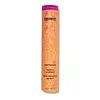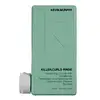What's inside
What's inside
 Key Ingredients
Key Ingredients

No key ingredients
 Benefits
Benefits

 Concerns
Concerns

 Ingredients Side-by-side
Ingredients Side-by-side

Water
Skin ConditioningCetearyl Alcohol
EmollientBehentrimonium Chloride
PreservativeParfum
MaskingGlycerin
HumectantButyrospermum Parkii Butter
Skin ConditioningHippophae Rhamnoides Fruit Extract
Skin ConditioningSilicone Quaternium-8
Trideceth-10
CleansingCapryloyl Glycerin/Sebacic Acid Copolymer
Skin ConditioningDiheptyl Succinate
EmollientIsopropyl Alcohol
SolventCocamide Mipa
EmulsifyingPolyquaternium-37
Caprylyl Glycol
EmollientPropylene Glycol Dicaprylate/Dicaprate
EmollientEthylhexylglycerin
Skin ConditioningHexylene Glycol
EmulsifyingPPG-1 Trideceth-6
Skin ConditioningCitric Acid
BufferingSodium Hydroxide
BufferingPhenoxyethanol
PreservativeButylphenyl Methylpropional
PerfumingLimonene
PerfumingHydroxycitronellal
PerfumingHydroxyisohexyl 3-Cyclohexene Carboxaldehyde
MaskingCitronellol
PerfumingWater, Cetearyl Alcohol, Behentrimonium Chloride, Parfum, Glycerin, Butyrospermum Parkii Butter, Hippophae Rhamnoides Fruit Extract, Silicone Quaternium-8, Trideceth-10, Capryloyl Glycerin/Sebacic Acid Copolymer, Diheptyl Succinate, Isopropyl Alcohol, Cocamide Mipa, Polyquaternium-37, Caprylyl Glycol, Propylene Glycol Dicaprylate/Dicaprate, Ethylhexylglycerin, Hexylene Glycol, PPG-1 Trideceth-6, Citric Acid, Sodium Hydroxide, Phenoxyethanol, Butylphenyl Methylpropional, Limonene, Hydroxycitronellal, Hydroxyisohexyl 3-Cyclohexene Carboxaldehyde, Citronellol
Water
Skin ConditioningCetearyl Alcohol
EmollientCapryloyl Glycerin/Sebacic Acid Copolymer
Skin ConditioningDiheptyl Succinate
EmollientBehentrimonium Methosulfate
Glycerin
HumectantAvena Sativa Kernel Extract
AbrasiveXanthan Gum
EmulsifyingPersea Gratissima Oil
Skin ConditioningHydroxyacetophenone
AntioxidantGuar Hydroxypropyltrimonium Chloride
Skin ConditioningCetrimonium Chloride
AntimicrobialPhenoxyethanol
PreservativePotassium Sorbate
PreservativeSodium Benzoate
MaskingCitric Acid
BufferingWater, Cetearyl Alcohol, Capryloyl Glycerin/Sebacic Acid Copolymer, Diheptyl Succinate, Behentrimonium Methosulfate, Glycerin, Avena Sativa Kernel Extract, Xanthan Gum, Persea Gratissima Oil, Hydroxyacetophenone, Guar Hydroxypropyltrimonium Chloride, Cetrimonium Chloride, Phenoxyethanol, Potassium Sorbate, Sodium Benzoate, Citric Acid
Ingredients Explained
These ingredients are found in both products.
Ingredients higher up in an ingredient list are typically present in a larger amount.
We don't have a description for Capryloyl Glycerin/Sebacic Acid Copolymer yet.
Cetearyl alcohol is a mixture of two fatty alcohols: cetyl alcohol and stearyl alcohol. It is mainly used as an emulsifier. Emulsifiers help prevent the separation of oils and products. Due to its composition, it can also be used to thicken a product or help create foam.
Cetearyl alcohol is an emollient. Emollients help soothe and hydrate the skin by trapping moisture.
Studies show Cetearyl alcohol is non-toxic and non-irritating. The FDA allows products labeled "alcohol-free" to have fatty alcohols.
This ingredient is usually derived from plant oils such as palm, vegetable, or coconut oils. There is debate on whether this ingredient will cause acne.
Due to the fatty acid base, this ingredient may not be Malassezia folliculitis safe.
Learn more about Cetearyl AlcoholCitric Acid is an alpha hydroxy acid (AHA) naturally found in citrus fruits like oranges, lemons, and limes.
Like other AHAs, citric acid can exfoliate skin by breaking down the bonds that hold dead skin cells together. This helps reveal smoother and brighter skin underneath.
However, this exfoliating effect only happens at high concentrations (20%) which can be hard to find in cosmetic products.
Due to this, citric acid is usually included in small amounts as a pH adjuster. This helps keep products slightly more acidic and compatible with skin's natural pH.
In skincare formulas, citric acid can:
While it can provide some skin benefits, research shows lactic acid and glycolic acid are generally more effective and less irritating exfoliants.
Most citric acid used in skincare today is made by fermenting sugars (usually from molasses). This synthetic version is identical to the natural citrus form but easier to stabilize and use in formulations.
Read more about some other popular AHA's here:
Learn more about Citric AcidWe don't have a description for Diheptyl Succinate yet.
Glycerin is already naturally found in your skin. It helps moisturize and protect your skin.
A study from 2016 found glycerin to be more effective as a humectant than AHAs and hyaluronic acid.
As a humectant, it helps the skin stay hydrated by pulling moisture to your skin. The low molecular weight of glycerin allows it to pull moisture into the deeper layers of your skin.
Hydrated skin improves your skin barrier; Your skin barrier helps protect against irritants and bacteria.
Glycerin has also been found to have antimicrobial and antiviral properties. Due to these properties, glycerin is often used in wound and burn treatments.
In cosmetics, glycerin is usually derived from plants such as soybean or palm. However, it can also be sourced from animals, such as tallow or animal fat.
This ingredient is organic, colorless, odorless, and non-toxic.
Glycerin is the name for this ingredient in American English. British English uses Glycerol/Glycerine.
Learn more about GlycerinPhenoxyethanol is a preservative that has germicide, antimicrobial, and aromatic properties. Studies show that phenoxyethanol can prevent microbial growth. By itself, it has a scent that is similar to that of a rose.
It's often used in formulations along with Caprylyl Glycol to preserve the shelf life of products.
Water. It's the most common cosmetic ingredient of all. You'll usually see it at the top of ingredient lists, meaning that it makes up the largest part of the product.
So why is it so popular? Water most often acts as a solvent - this means that it helps dissolve other ingredients into the formulation.
You'll also recognize water as that liquid we all need to stay alive. If you see this, drink a glass of water. Stay hydrated!
Learn more about Water